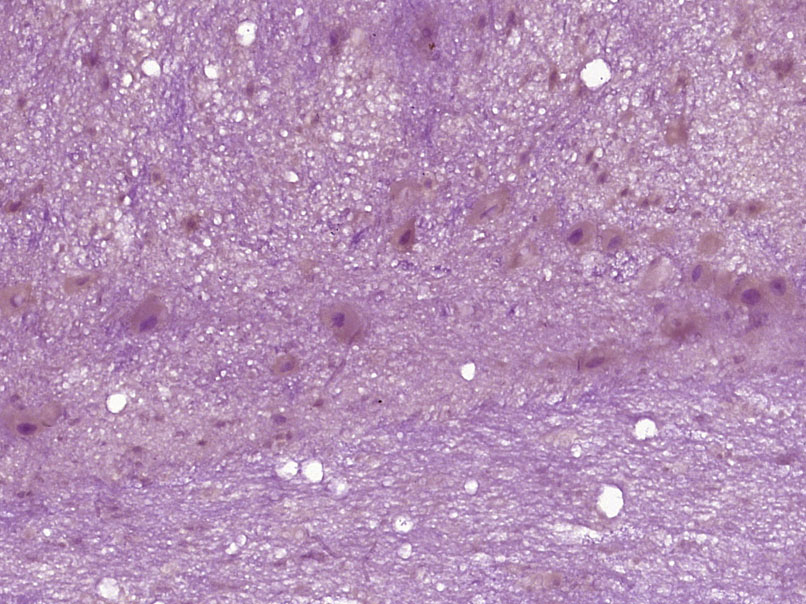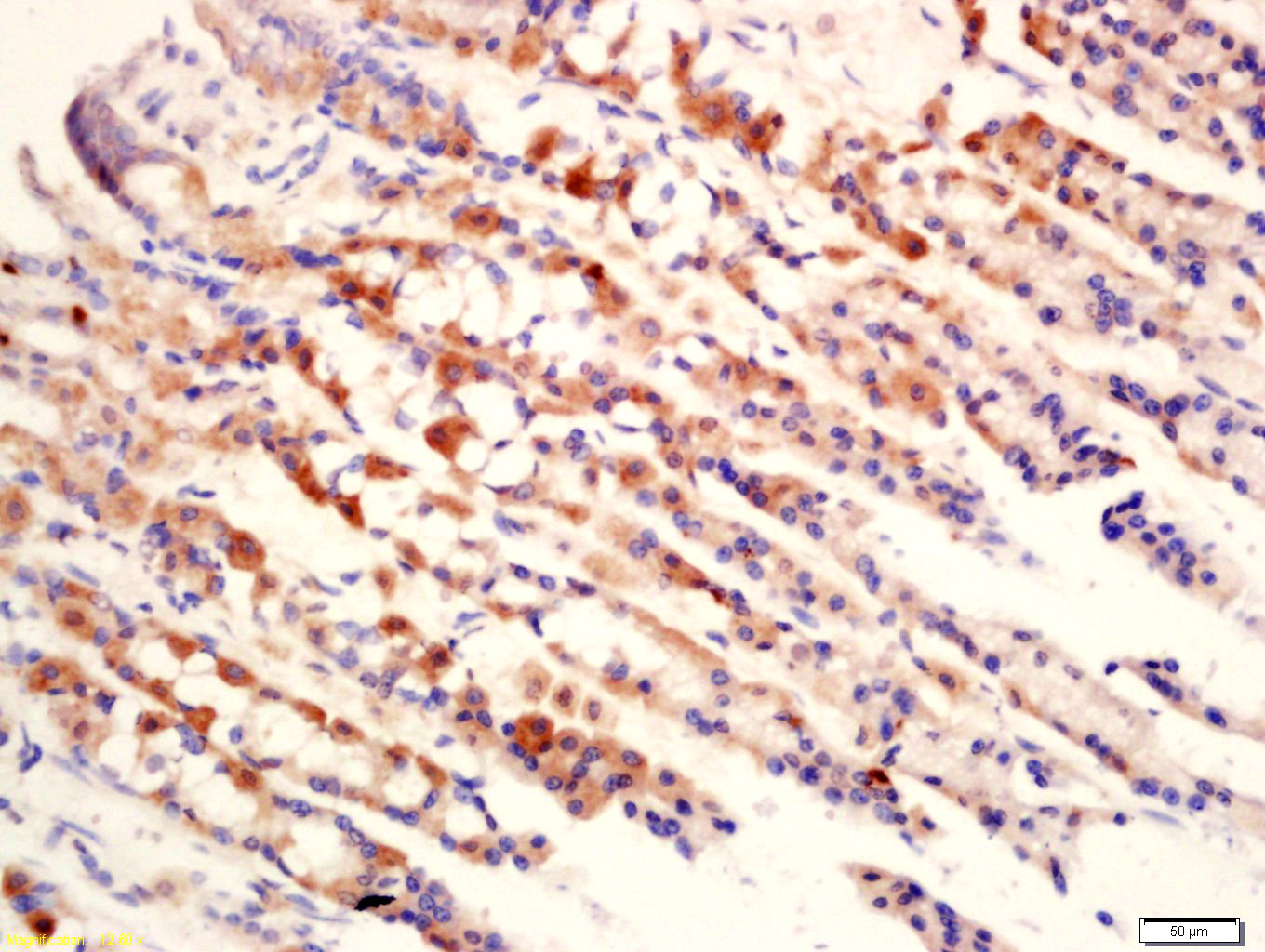
Rabbit Anti-Caldesmon antibody
CAD; CALD 1; CALD1; Caldesmon 1; Caldesmon 1 Isoform 1; Caldesmon 1 Isoform 2; aldesmon 1 Isoform 3; Caldesmon 1 Isoform 4; Caldesmon 1 Isoform 5; Caldesmon1; CDM; H CAD; HCAD; L CAD; LCAD; MGC21352; NAG22; Caldesmon-Pan; CALD1_HUMAN.
View History [Clear]
Details
Product Name Caldesmon Chinese Name 钙介质素抗体 Alias CAD; CALD 1; CALD1; Caldesmon 1; Caldesmon 1 Isoform 1; Caldesmon 1 Isoform 2; aldesmon 1 Isoform 3; Caldesmon 1 Isoform 4; Caldesmon 1 Isoform 5; Caldesmon1; CDM; H CAD; HCAD; L CAD; LCAD; MGC21352; NAG22; Caldesmon-Pan; CALD1_HUMAN. Research Area immunology Immunogen Species Rabbit Clonality Polyclonal React Species Rat, (predicted: Human, Mouse, Chicken, Dog, Cow, Rabbit, ) Applications ELISA=1:5000-10000 IHC-P=1:100-500 IHC-F=1:100-500 ICC=1:100-500 IF=1:100-500 (Paraffin sections need antigen repair)
not yet tested in other applications.
optimal dilutions/concentrations should be determined by the end user.Theoretical molecular weight 94kDa Cellular localization cytoplasmic Form Liquid Concentration 1mg/ml immunogen KLH conjugated synthetic peptide derived from human Caldesmon: 701-798/798 Lsotype IgG Purification affinity purified by Protein A Buffer Solution 0.01M TBS(pH7.4) with 1% BSA, 0.03% Proclin300 and 50% Glycerol. Storage Shipped at 4℃. Store at -20 °C for one year. Avoid repeated freeze/thaw cycles. Attention This product as supplied is intended for research use only, not for use in human, therapeutic or diagnostic applications. PubMed PubMed Product Detail This gene encodes a calmodulin- and actin-binding protein that plays an essential role in the regulation of smooth muscle and nonmuscle contraction. The conserved domain of this protein possesses the binding activities to Ca(2+)-calmodulin, actin, tropomyosin, myosin, and phospholipids. This protein is a potent inhibitor of the actin-tropomyosin activated myosin MgATPase, and serves as a mediating factor for Ca(2+)-dependent inhibition of smooth muscle contraction. Alternative splicing of this gene results in multiple transcript variants encoding distinct isoforms.[provided by RefSeq, Jul 2008].
Function:
Actin- and myosin-binding protein implicated in the regulation of actomyosin interactions in smooth muscle and nonmuscle cells (could act as a bridge between myosin and actin filaments). Stimulates actin binding of tropomyosin which increases the stabilization of actin filament structure. In muscle tissues, inhibits the actomyosin ATPase by binding to F-actin. This inhibition is attenuated by calcium-calmodulin and is potentiated by tropomyosin. Interacts with actin, myosin, two molecules of tropomyosin and with calmodulin. Also play an essential role during cellular mitosis and receptor capping. Involved in Schwann cell migration during peripheral nerve regeneration.
Subcellular Location:
Cytoplasm, cytoskeleton. Cytoplasm, myofibril. Note=On thin filaments in smooth muscle and on stress fibers in fibroblasts (nonmuscle).
Tissue Specificity:
High-molecular-weight caldesmon (isoform 1) is predominantly expressed in smooth muscles, whereas low-molecular-weight caldesmon (isoforms 2, 3, 4 and 5) are widely distributed in non-muscle tissues and cells. Not expressed in skeletal muscle or heart.
Post-translational modifications:
In non-muscle cells, phosphorylation by CDK1 during mitosis causes caldesmon to dissociate from microfilaments. Phosphorylation reduces caldesmon binding to actin, myosin, and calmodulin as well as its inhibition of actomyosin ATPase activity. Phosphorylation also occurs in both quiescent and dividing smooth muscle cells with similar effects on the interaction with actin and calmodulin and on microfilaments reorganization. CDK1-mediated phosphorylation promotes Schwann cell migration during peripheral nerve regeneration (By similarity).
Similarity:
Belongs to the caldesmon family.
SWISS:
Q05682
Gene ID:
800
Database links:Entrez Gene: 800 Human
Entrez Gene: 109624 Mouse
Omim: 114213 Human
SwissProt: Q05682 Human
SwissProt: Q8VCQ8 Mouse
Unigene: 490203 Human
Caldesmon是一种平滑肌肌动蛋白和钙调蛋白的Binding protein,被认为是一种平滑肌细胞的Maker,存在于平滑肌或非平滑肌细胞中的一种Cytoskeleton蛋白。它可以与肌动蛋白、肌球蛋白、原肌球蛋白和钙调蛋白相互作用,是平滑肌细胞的一个Maker,可用于判断子宫Tumour来源。在结肠直肠Tumour中是区分纤维细胞和肌纤维细胞的一个Maker。Product Picture
Antigen retrieval: citrate buffer ( 0.01M, pH 6.0 ), Boiling bathing for 15min; Block endogenous peroxidase by 3% Hydrogen peroxide for 30min; Blocking buffer (normal goat serum,C-0005) at 37℃ for 20 min;
Incubation: Anti-Caldesmon Polyclonal Antibody, Unconjugated(SL1589R) 1:200, overnight at 4°C, followed by conjugation to the secondary antibody(SP-0023) and DAB(C-0010) staining
Bought notes(bought amounts latest0)
No one bought this product
User Comment(Total0User Comment Num)
- No comment




 +86 571 56623320
+86 571 56623320
 +86 18668110335
+86 18668110335

